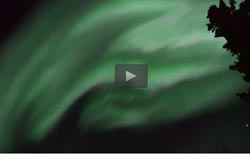

This is a flickering aurora. The pale pink area at the center is flickering. Filmed by: Ayumi Y. Bakken, filmed at: Fairbanks, AK, USA; filming date: March 18, 2015; playback speed: 1x.
Credit: Ayumi Y. Bakken
Dr. Yoko Fukuda (formally of the Graduate School of Science at The University of Tokyo), Dr. Ryuho Kataoka of the National Institute of Polar Research, and other collaborators conducted a 3 year continuous high-speed imaging observation at Poker Flat Research Range, Alaska, USA, and identified the physics behind the flickering. At the same time, they discovered faster flickerings at speeds of 1/60-1/50 and 1/80 of a second.
On March 19, 2016, the researchers observed an aurora with the brightness that ranked within the top 5 of all observations since 2014, and was filmed with a 1/160 second shutter speed camera. Detailed analysis of the footage showed a high-speed flickering aurora vibrating with a 1/80 second period taking place during the brightest moment of the breakup.
“High-speed flickering at 1/80 seconds could not be explained by oxygen ions alone. Lighter ions, such as those from hydrogen, are thought to be contributing to the flickering,” explains Dr. Fukuda. “The fact that this high-speed flickering was observed at the same time as flickering with a typical 1/10 second period may mean that the flickering aurora was caused by 'electromagnetic ion cyclotron waves' (*2), which are affected by both oxygen and hydrogen ions.”
At altitudes of several thousand kilometers, various plasma waves are excited by accelerating electrons and ions. These electrons are what eventually generate auroras. It is assumed that a complex exchange of energy, in which plasma waves are affected by electrons and ions and vice versa, takes place here.
“Astronomical objects with magnetic fields are found throughout the cosmos, with Earth being one of them. On such objects, we observe excitation of plasma waves by accelerating particles, and the interactions between plasma waves and particles, are occurring all over the place,” concludes Dr. Kataoka. “However, Earth is the only place we can observe these phenomena in detail. Understanding the behavior of plasma in outer space, and the interactions between plasma waves and particles is a fundamental question in geophysics. We will continue to investigate them in the future.”
###
*1: Ion cyclotron frequency
The circular motion of electrons and ions around a magnetic field line is called cyclotron motion. Ion cyclotron frequency is the number of times per second that the electrons and ions circle around the field line. It is inversely proportional to the mass of the electrons and ions–the frequency is greater if the mass is lighter. The frequency also correlates with the strength of the magnetic field; it is greater at lower altitudes where the magnetic field is stronger.
*2: Electromagnetic ion cyclotron waves
A type of wave that can exist in a plasma (such as the region of space above Earth's aurora), which vibrates at an ion cyclotron frequency that corresponds to the ion type present (oxygen, helium, hydrogen, etc.).
This is a joint press release by National Institute of Polar Research(NIPR), The University of Tokyo, Nagoya University, Kyoto University, University of Alaska, Fairbanks and University of Southampton.















